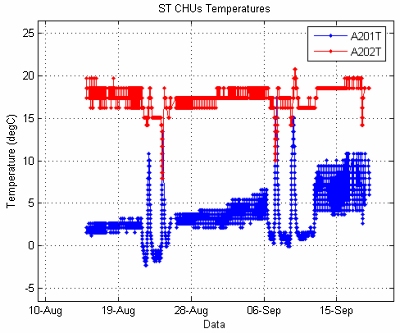No. 43 - End of Electric Propulsion Operations
The engine was finally shutdown on 17 September. From now on, SMART-1 will be left in a natural orbit determined by lunar gravity and perturbations caused by gravitational influence of the Earth and Sun. The preliminary orbit propagation done by Flight Dynamics indicates that SMART-1 will end its life naturally, through impact with the Moon's surface, around mid August 2006.
Scientific operations will be resumed on 1 October aiming at the conduction of push-broom operations from 20 October 2005, 00h, to 19 December 2005 when the Sun will be within 30° of the orbit plane. Payload activities during the reporting period have been restricted to SPEDE/EPDP monitoring of the EP thrust. The other instruments remained inactive during the EP operations.
| Electric Propulsion System operations history | |
| Number of Pulses | 844 |
| Total number of hours fired (h) | 4958.3 |
| First Pulse | 12:25 UTC, 30 Sep 2003 |
| Last Pulse | 18:45 UTC, 17 Sep 2005 |
| Cathode A firing time (h) | 3865 |
| Cathode B firing time (h) | 1106 |
| Number of nominal BB activations | 1 256 505 |
| Xenon at launch (kg) | 82.5 |
| Remaining Xenon (g) | 280 |
| Remaining useable Xenon (g) | ~ 60 |
| EP Power set range used during the mission (W) | 649 - 1417 |
| Number of OSET (Opto-coupler Single Event Transient) | 38 |
Future Activities
- Start work for next phase of ground automation activities
- Forced Thermal Low after the eclipse season
- SMART-1 presentations at international conferences:
SMART-1 Lunar Mission: Reducing Mission Operations Costs Kyoto, Japan 11-13 October SMART-1 Operations Fukuoka, Japan 17-21 October SMART-1 Lunar Mission: Operational experience with its Automatic Attitude and Orbit Control Subsystem and its relation with Electric Propulsion System Loutraki, Greece 17-21 October SMART-1 Lunar Mission: Startracker Operations Experience Loutraki, Greece 17-21 October Operationally Enhanced Electric Propulsion Performance on Electrically Propelled Spacecraft Princeton, USA 1 November
Spacecraft Status
AOCS
The AOC subsystem has done well in the period covered by this report. The figure shows the startracker (ST) CCD temperatures for the reporting period. The temperature for the Camera Head Unit 2 (CHU2) CCD has been relatively high during the entire period with an average temperature of 17.38 °C and a maximum temperature of 20.8 °C. The reason for the CHU2 CCD temperature being this high is that the spacecraft has been pointing with its +X axis to the Sun during most of this period except for four occasions when the spacecraft was pointing with the +X to Earth for high rate communications using the Medium Gain Antenna (MGA).
It is known that pointing the +X axis to the Sun exposes the CHU2 inner baffle slightly which is enough to get the CHU2 CCD temperature close to or above the operational limit. Temperatures for CHU1 have been low for most of the reporting period with temperatures below 10 °C except for the four occasions that correspond to MGA pointing to Earth where the peak temperatures reached 17.38 °C.
 |
|
ST CCD Temperatures (A201T= CCD1; A202T=CCD2) |
The following table lists the temperature statistics for this period.
| Camera Head Unit |
Min. T (°C) |
Max. T (°C) |
Average (°C) |
| CHU1 |
-2.27 |
17.38 |
3.6 |
| CHU2 |
7.92 |
20.8 |
17.38 |
Electric Propulsion, Power and Thermal
The Power Subsystem has been working very well during the reporting period including the eclipse of 42% of the solar disk during an occultation on 18 September between 01:59:57 and 02:16:09.
To achieve the mission extension orbit, the ion drive was activated throughout the period 10:23 (UTC), 2 August 2005 to 18:45 (UTC), 17 September 2005, creating an outwardly spiralling orbit. More details on these activities will appear in a future report.
The orbital status at the start of the re-boost phase was:
| Radius of Perilune (km) |
2172 |
| Radius of Apolune (km) |
4634 |
| Inclination (°) |
90.264 |
| Right Ascending Node (°) |
237.344 |
| Argument of Perigee (°) |
243.860 |
| Amount of Xenon left (kg) |
~ 6.0 |
Orbital Information
|
SMART-1 OD360 Close to Apolune 1216 Elements WRT Moon and its equator of date | |
| Pericentre Distance (km) | 2189.702737 |
| Apocentre Distance (km) | 4644.003693 |
| Semi Major Axis (km) | 3416.853215 |
| Eccentricity | 0.359146 |
| Inclination (°) | 90.188741 |
| Ascending Node (°) | 237.721939 |
| Argument of Pericentre (°) | 292.930856 |
| True Anomaly (°) | 180.000008 |
| Osculating Orbital Period (h) | 4.978457 |
The changes since apolune 1182 are as follows:
- semi-major axis -2.0 km
- perilune height +2.5 km
- apolune height -6.5 km
- orbital period -0.3 min
